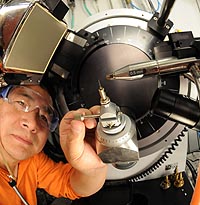The discovery of a compound that emits radiation, which could one day be used as a component in high-efficiency optical fibers and sensors to detect chemical or biological warfare weapons from a long distance, was almost missed by the scientists since the examination of its structure was too complex

The discovery of a radiation-emitting compound, which could one day be used as a component in high-efficiency optical fibers and sensors to detect chemical or biological warfare weapons from a long distance, was almost missed by the scientists since the examination of its structure was too complex. Fortunately, scientists from the US Department of Energy and researchers from Northwestern University were able to determine the structure of the compound with the help of highly advanced optical measuring instruments.
"Like similar materials, this material has an electronically polarized structure. "External radiation reacts with the electron "cloud" and during their meeting, a distortion is created in the structure of the cloud," said researcher Mercouri Kanatzidis. "The interference changes the wavelength of the emitted light and creates two rays: one - the original, and a second harmonic - a ray with half the original wavelength and twice its frequency."
This second ray is fifteen times more powerful than any other ray derived from the most effective materials known today. This ray is accompanied by a higher level of transparency, so that the material can actually transmit all of the original ray through it. This fact could help in the development of applications that would be able to detect chemical and biological warfare agents from a long distance and in other communication and optical devices.
However, these features were almost overlooked. The material, described by the structural formula (A)ZrPSe6, where A can be potassium, rubidium or cesium, has a unique and complex chemical structure that does not allow good formation of the material. It "grows" lengthwise, but not in other directions. As a result, long and thin crystals are obtained - perfect for applications in optical fibers but quite a challenge for examining them with normal measuring devices. "It is not easy to produce or annoy them," says the researcher. "The material does not tend to grow in other directions."
Using advanced measuring devices, the research team was able to determine the structure of the material and examine its extraordinary properties. The device they used is designed for X-ray crystallography of very small crystals operated at the University of Chicago.
The press release of the research institute
More on the subject on the science website
